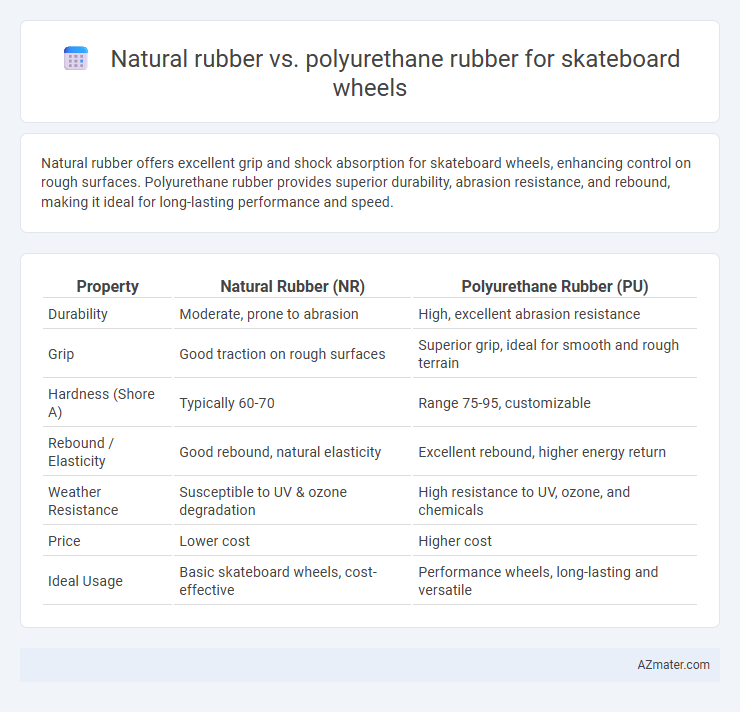Natural rubber offers excellent grip and shock absorption for skateboard wheels, enhancing control on rough surfaces. Polyurethane rubber provides superior durability, abrasion resistance, and rebound, making it ideal for long-lasting performance and speed.
Table of Comparison
| Property | Natural Rubber (NR) | Polyurethane Rubber (PU) |
|---|---|---|
| Durability | Moderate, prone to abrasion | High, excellent abrasion resistance |
| Grip | Good traction on rough surfaces | Superior grip, ideal for smooth and rough terrain |
| Hardness (Shore A) | Typically 60-70 | Range 75-95, customizable |
| Rebound / Elasticity | Good rebound, natural elasticity | Excellent rebound, higher energy return |
| Weather Resistance | Susceptible to UV & ozone degradation | High resistance to UV, ozone, and chemicals |
| Price | Lower cost | Higher cost |
| Ideal Usage | Basic skateboard wheels, cost-effective | Performance wheels, long-lasting and versatile |
Introduction to Skateboard Wheel Materials
Skateboard wheels typically use natural rubber or polyurethane, each offering distinct performance characteristics. Natural rubber provides superior grip and a softer ride but wears down faster and lacks abrasion resistance compared to polyurethane. Polyurethane wheels dominate the market due to their enhanced durability, better resistance to wear, and improved rebound, making them ideal for various skateboarding styles and surfaces.
Overview of Natural Rubber and Polyurethane Rubber
Natural rubber offers excellent elasticity and high tensile strength, making it a traditional choice for various applications requiring flexibility and durability. Polyurethane rubber provides superior abrasion resistance, higher load-bearing capacity, and enhanced chemical resistance, which significantly improves skateboard wheel performance and longevity. The balance between natural rubber's natural cushioning and polyurethane's tough, resilient properties determines the best material for specific skating styles and surfaces.
Physical Properties Comparison
Natural rubber offers excellent elasticity and high tensile strength, providing superior impact absorption and a smooth ride on rough surfaces. Polyurethane rubber features greater hardness and abrasion resistance, resulting in increased durability and enhanced grip on various terrains. While natural rubber excels in flexibility and shock absorption, polyurethane's physical properties favor longevity and performance in demanding skateboarding conditions.
Durability and Longevity
Polyurethane rubber outperforms natural rubber in skateboard wheel durability, exhibiting higher resistance to abrasion, cuts, and deformation under repeated stress. Natural rubber, while flexible and offering good grip, tends to wear down faster due to its lower resistance to environmental factors and mechanical strain. Polyurethane's superior longevity ensures consistent performance, maintaining wheel shape and resilience over extended use, which makes it the preferred material for high-quality skateboard wheels.
Grip and Traction Differences
Natural rubber skateboard wheels provide superior grip and traction due to their high elasticity and excellent surface adhesion, making them ideal for smooth pavement or street skating. Polyurethane rubber wheels offer enhanced durability and resistance to abrasion, but typically have less grip compared to natural rubber, favoring speed and longevity over maximum traction. The molecular structure of natural rubber allows for better energy absorption and stickiness, whereas polyurethane's harder composition results in reduced surface contact and traction.
Ride Comfort and Shock Absorption
Natural rubber skateboard wheels offer superior ride comfort due to their excellent elasticity and natural damping properties, effectively absorbing vibrations from rough surfaces. Polyurethane rubber wheels provide enhanced shock absorption with higher resilience and abrasion resistance, delivering a smoother ride on varied terrains. While natural rubber excels in cushioning small impacts, polyurethane rubber balances durability and comfort for optimal performance in skateboarding.
Weather and Temperature Performance
Natural rubber skateboard wheels exhibit excellent grip and flexibility in moderate temperatures but tend to harden and lose traction in cold weather, limiting performance at low temperatures. Polyurethane rubber wheels maintain consistent hardness and resilience across a wide temperature range, providing superior durability and better control on hot or cold pavement. Temperature-resistant polyurethane compounds resist deformation and wear, ensuring optimal skateboard wheel performance in varying weather conditions.
Cost and Availability
Natural rubber skateboard wheels are generally more cost-effective due to the abundant global supply of latex from rubber trees, making them widely available and affordable for mass production. Polyurethane wheels, while typically more expensive, offer enhanced durability and performance, resulting in longer-lasting wheels but with a higher initial investment. Availability of polyurethane is robust in specialized markets, but natural rubber remains more accessible for standard skateboard wheel manufacturing due to established production channels.
Environmental Impact and Sustainability
Natural rubber skateboard wheels are derived from renewable latex harvested from rubber trees, offering biodegradability and a lower carbon footprint compared to synthetic alternatives. Polyurethane rubber wheels, while providing superior durability and performance, are petroleum-based and contribute to microplastic pollution with limited recycling options. Choosing natural rubber supports reduced environmental impact and aligns with sustainability goals in eco-conscious skateboarding communities.
Best Applications and Recommendations
Natural rubber skateboard wheels offer excellent grip and shock absorption, making them ideal for cruising and rough terrain where traction is crucial. Polyurethane wheels provide superior durability and resistance to abrasion, which is best suited for street skating and technical tricks requiring smooth slides and high rebound performance. For longevity and all-around versatility, polyurethane is recommended, while natural rubber suits riders prioritizing a softer, more cushioned riding experience.

Infographic: Natural rubber vs Polyurethane rubber for Skateboard wheel
 azmater.com
azmater.com